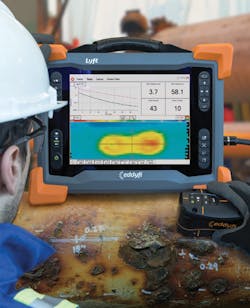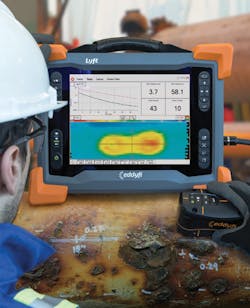Corrosion under insulation poses major threat to offshore asset integrity
Archie Crawford
Bilfinger Salamis
The battle against corrosion is an ever-present issue for the offshore oil and gas industry, with structures, pipework, and equipment widely exposed to seawater and humid, salty air.
Corrosion under insulation (CUI) is a major and well-understood threat, and the industry is researching new technology to help identify the impact earlier and more reliably. Mainly, CUI affects steel components, which corrode when they are in contact with water and air.
Insulation of plant and pipework can create a space where water can collect and rest against the metal surface over extended periods of time. With outdoor equipment, even very small gaps in insulating cladding can let in sufficient volumes of water to cause significant corrosion issues.
Advances in imaging technology are providing offshore maintenance crews with much more data on the ‘hidden’ condition of their assets than was available 10 years ago. (Photo courtesy Bilfinger Salamis)
A further dilemma created by insulation is that it can hide the effects of the corrosion from view, so that a heavily corroded pipe can appear normal when visually inspected. But by the time the effects have become clearly visible from the outside – often in the form of particles of oxidized metal or discolored water running off – significant damage may already have occurred.
Removing insulation to check the condition of pipework is a laborious process and a costly method of assessing the condition of an asset. Maintenance specialists have developed a suite of different solutions that can make managing CUI across an installation more efficient and help ensure pipes and structures conform to HSE guidelines.
Inspection efficiency
The biggest cost associated with inspecting for corrosion is manpower, and this is exacerbated in the case of offshore facilities – mobilizing the right personnel onboard and ensuring that they receive the correct briefing is a time-consuming process. The focus must therefore be on minimizing the resources needed to carry out the work. The preferred approach is for the inspection and fabric maintenance departments to work together, using three-man teams comprising an inspector, insulator and painter, all of whom are rope access-qualified. Keeping the teams as small as possible can lead to considerable reductions in cost.
It is better still to avoid the process of transporting new people to site to perform an inspection by instead training team members already on location to handle inspection work. Advances in technology to help automate the process have played a big part in making this possible, increasing the efficiency and effectiveness of inspection crews. Equipping teams with CUI detection tools such as digital radiography and pulsed eddy current (PEC) technology can significantly speed up site inspection processes and improve the likelihood of early detection.
Although radiographic and PEC imaging are not new, the techniques used to perform inspections have advanced rapidly. Previously each radiographic exposure took several minutes to capture and subsequently needed to be processed using lab equipment. These steps can now be taken in a matter of seconds and images can be viewed on the spot on a mobile device.
As recently as five years ago PEC readings needed to be performed on a point-to-point basis, making it time-consuming to capture all the angles and positions required to scan a length of pipework. In response, Bilfinger worked with imaging specialist Eddyfi to develop a system that runs continuously. This cuts the time taken and significantly increases the number of data points available, providing greater certainty of results. Using mobile data processing devices, engineers can now output easy-to-interpret condition reports showing the location and extent of any defects without any need for desktop analysis. This means response times to priority corrosion issues can be much faster.
Case study
Bilfinger was called in by a contractor operating a platform for a major global energy company to renew the insulation on all exterior pipework where CUI was detected. The existing insulation was mineral wool, enclosed in neoprene cladding, and the cause of the CUI in each case was failure of the elastomeric sealant used in the joints between sections.
Where replacements were needed, the mineral wool was replaced with foam glass. This was clad in banding tape sealed with Terostat PC vapor-barrier mastic, a long-life sealant proven to deliver better resistance than elastomeric options. The insulation was applied in the form of pre-fabricated shells supplied tailor-made, allowing fast installation on site and reducing costs.
The scale of the project, which involved replacing hundreds of meters of insulation, meant that the works took place over several months. Throughout delivery, the project team provided a monthly report with information on productivity, tool-time, costs, man allocation hours, work pack tracker, health safety, environment and quality CUI statistics and linear distance re-insulated.
Conclusion
CUI is critical, especially where ageing infrastructure is involved, and the current trend for maximizing the lifespan of large pieces of offshore infrastructure presents increased challenges, especially at mature fields on the UK continental shelf. Failure to manage CUI can, at best, lead to expensive and time-consuming maintenance operations; at worst, it can pose a major threat to the safety of facilities and personnel, so this is not an area offshore operators can afford to overlook.
The financial burden involved in performing inspections can be significant, but advances in both inspection technology and strategies have dramatically increased the efficiency of the process in recent years, decreasing the temptation to push back or skip what is an essential safety monitoring process.




